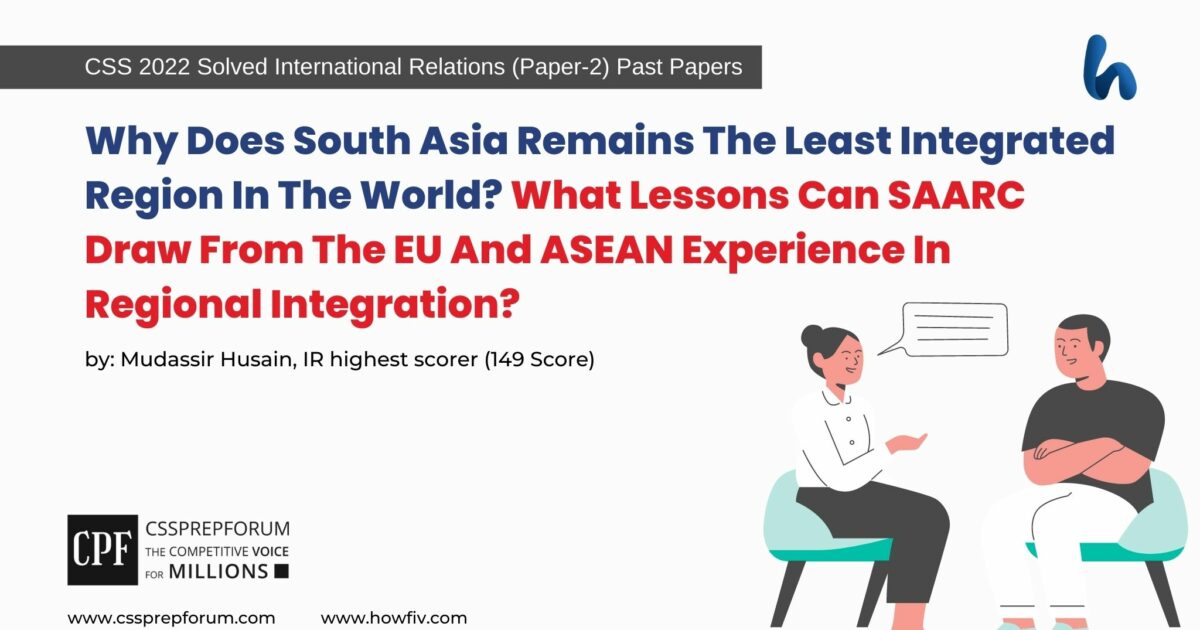Q4. Why does South Asia remain the least integrated region in the world? What lessons can SAARC draw from the EU and ASEAN experience in regional integration?

South Asia remains one of the least integrated regions in the world due to several key factors:
1. Historical and Political Factors: South Asia has a history of conflicts, border disputes, and political tensions among its countries. Historical legacies, such as the partition of British India into India and Pakistan, have left deep-rooted issues and mistrust, making regional cooperation and integration challenging.
2. Bilateral Disputes: Bilateral disputes, particularly the long-standing conflict between India and Pakistan over Kashmir, have hindered progress in regional integration. These disputes often overshadow broader regional initiatives and prevent meaningful cooperation.
3. Economic Disparities: South Asian countries vary significantly in terms of economic development and levels of industrialization. This economic disparity, coupled with protectionist policies, trade barriers, and inadequate infrastructure, inhibits regional trade and cooperation.
4. Lack of Trust and Confidence: There is a lack of mutual trust and confidence among South Asian countries, which affects their willingness to collaborate and integrate. Historical grievances, political rivalries, and security concerns contribute to this trust deficit.
5. Non-Tariff Barriers and Regulatory Challenges: Non-tariff barriers, including bureaucratic hurdles, complex regulations, and inefficient customs procedures, impede trade and economic integration in the region. Harmonizing regulations and reducing these barriers is crucial for enhanced regional integration.
SAARC (South Asian Association for Regional Cooperation) can draw lessons from the experiences of regional integration in the EU (European Union) and ASEAN (Association of Southeast Asian Nations) to foster greater integration in South Asia. Some key lessons include:
1. Gradual Approach: Both the EU and ASEAN took a gradual approach to integration, starting with cooperation in specific sectors before expanding to broader economic and political integration. SAARC can follow a similar phased approach, focusing on targeted areas of cooperation to build confidence and momentum.
2. Focus on Trade and Economic Integration: Economic integration played a vital role in the success of the EU and ASEAN. SAARC can prioritize trade facilitation, harmonization of regulations, reduction of non-tariff barriers, and the establishment of a common market to enhance economic integration and encourage intra-regional trade.
3. People-to-People Connectivity: The EU and ASEAN emphasized people-to-people connectivity through initiatives such as free movement of goods, services, and labor. SAARC can work towards easing visa restrictions, promoting tourism, and enhancing cultural exchanges to foster greater people-to-people connectivity and understanding.
4. Conflict Resolution Mechanisms: The EU and ASEAN developed conflict resolution mechanisms to address disputes peacefully. SAARC can strengthen its mechanisms for resolving conflicts and promote dialogue among member states to address bilateral issues effectively.
5. Infrastructure Development: The EU and ASEAN prioritized infrastructure development to improve connectivity within their regions. SAARC can invest in cross-border infrastructure projects, such as transportation networks and energy corridors, to enhance physical connectivity and promote regional integration.
6. Institutional Strengthening: SAARC can learn from the EU and ASEAN’s institutional frameworks and governance structures to enhance its own capacity and effectiveness. Strengthening the secretariat and streamlining decision-making processes can contribute to greater regional integration.
In conclusion, South Asia remains the least integrated region due to historical, political, economic, and trust-related challenges. SAARC can draw lessons from the EU and ASEAN’s experiences to promote regional integration by adopting a gradual approach, prioritizing economic integration, fostering people-to-people connectivity, developing conflict resolution mechanisms, investing in infrastructure, and strengthening institutional frameworks.